Glaciogenic Periglacial Landform in the Making—Geomorphological Evolution of a Rockfall on a Small Glacier in the Horlachtal, Stubai Alps, Austria
Abstract
1. Introduction
2. Materials and Methods
2.1. Study Area
2.2. Data and Data Pre-Processing
2.2.1. Digital Elevation Models
2.2.2. Orthophotos
2.2.3. Satellite Images
2.3. Glacier and Landform Mapping
2.4. Characterization of Rockfalls
2.5. Estimation of Initial Debris Thickness
2.6. Measurement of Surface Elevation Changes and Estimation of Ice Thickness Development
2.7. Measurement of the Surface Flow Velocities
3. Results
3.1. Evolution of the Zwieselbachferner
3.2. Evolution of the Landform
4. Discussion
4.1. Methodological Limitations
4.2. Similar Landforms
4.3. Interpretation of Landform Development
4.4. Future Development of the Landform
4.4.1. Ice Thickness
4.4.2. Surface Morphology
4.4.3. Permafrost Conditions
4.4.4. Sediment and Ice Supply
4.4.5. Flow Velocity
5. Conclusions
Supplementary Materials
Author Contributions
Funding
Data Availability Statement
Acknowledgments
Conflicts of Interest
References
- Hugonnet, R.; McNabb, R.; Berthier, E.; Menounos, B.; Nuth, C.; Girod, L.; Farinotti, D.; Huss, M.; Dussaillant, I.; Brun, F.; et al. Accelerated global glacier mass loss in the early twenty-first century. Nature 2021, 592, 726–731. [Google Scholar] [CrossRef] [PubMed]
- Zemp, M.; Huss, M.; Thibert, E.; Eckert, N.; McNabb, R.; Huber, J.; Barandun, M.; Machguth, H.; Nussbaumer, S.U.; Gärtner-Roer, I.; et al. Global glacier mass changes and their contributions to sea-level rise from 1961 to 2016. Nature 2019, 568, 382–386. [Google Scholar] [CrossRef] [PubMed]
- Fischer, A.; Seiser, B.; Stocker Waldhuber, M.; Mitterer, C.; Abermann, J. Tracing glacier changes in Austria from the Little Ice Age to the present using a lidar-based high-resolution glacier inventory in Austria. Cryosphere 2015, 9, 753–766. [Google Scholar] [CrossRef]
- Zekollari, H.; Huss, M.; Farinotti, D. Modelling the future evolution of glaciers in the European Alps under the EURO-CORDEX RCM ensemble. Cryosphere 2019, 13, 1125–1146. [Google Scholar] [CrossRef]
- Ballantyne, C.K. Periglacial Geomorphology; John Wiley & Sons Incorporated: Somerset, UK, 2017; ISBN 978-1-405-10006-9. [Google Scholar]
- Ballantyne, C.K. Paraglacial geomorphology. Quat. Sci. Rev. 2002, 21, 1935–2017. [Google Scholar] [CrossRef]
- Iturrizaga, L. Paraglacial Landscape Transformations. In Encyclopedia of Snow, Ice and Glaciers; Singh, V.P., Singh, P., Haritashya, U.K., Eds.; Springer: Dordrecht, The Netherlands, 2011; pp. 817–823. ISBN 978-90-481-2641-5. [Google Scholar]
- Heckmann, T.; Morche, D. Geomorphology of Proglacial Systems; Springer International Publishing: Cham, Switzerland, 2019; ISBN 978-3-319-94182-0. [Google Scholar]
- Hartmeyer, I.; Delleske, R.; Keuschnig, M.; Krautblatter, M.; Lang, A.; Schrott, L.; Otto, J.-C. Current glacier recession causes significant rockfall increase: The immediate paraglacial response of deglaciating cirque walls. Earth Surf. Dynam. 2020, 8, 729–751. [Google Scholar] [CrossRef]
- Etzelmüller, B.; Guglielmin, M.; Hauck, C.; Hilbich, C.; Hoelzle, M.; Isaksen, K.; Noetzli, J.; Oliva, M.; Ramos, M. Twenty years of European mountain permafrost dynamics—The PACE legacy. Environ. Res. Lett. 2020, 15, 104070. [Google Scholar] [CrossRef]
- Smith, S.L.; O’Neill, H.B.; Isaksen, K.; Noetzli, J.; Romanovsky, V.E. The changing thermal state of permafrost. Nat. Rev. Earth Environ. 2022, 3, 10–23. [Google Scholar] [CrossRef]
- Gruber, S.; Haeberli, W. Permafrost in steep bedrock slopes and its temperature-related destabilization following climate change. J. Geophys. Res. 2007, 112, F02S18. [Google Scholar] [CrossRef]
- Krautblatter, M.; Funk, D.; Günzel, F.K. Why permafrost rocks become unstable: A rock-ice-mechanical model in time and space. Earth Surf. Process. Landf. 2013, 38, 876–887. [Google Scholar] [CrossRef]
- Deline, P.; Gruber, S.; Delaloye, R.; Fischer, L.; Geertsema, M.; Giardino, M.; Hasler, A.; Kirkbride, M.; Krautblatter, M.; Magnin, F.; et al. Ice Loss and Slope Stability in High-Mountain Regions. Snow and Ice-Related Hazards, Risks and Disasters; Elsevier: Amsterdam, The Netherlands, 2015; pp. 521–561. ISBN 9780123948496. [Google Scholar]
- Knoflach, B.; Tussetschläger, H.; Sailer, R.; Meißl, G.; Stötter, J. High mountain rockfall dynamics: Rockfall activity and runout assessment under the aspect of a changing cryosphere. Geogr. Ann. Ser. A Phys. Geogr. 2021, 103, 83–102. [Google Scholar] [CrossRef]
- van Woerkom, T.; Steiner, J.F.; Kraaijenbrink, P.D.A.; Miles, E.S.; Immerzeel, W.W. Sediment supply from lateral moraines to a debris-covered glacier in the Himalaya. Earth Surf. Dynam. 2019, 7, 411–427. [Google Scholar] [CrossRef]
- Scherler, D.; Bookhagen, B.; Strecker, M.R. Hillslope-glacier coupling: The interplay of topography and glacial dynamics in High Asia. J. Geophys. Res. 2011, 116, F02019. [Google Scholar] [CrossRef]
- Deline, P. Change in surface debris cover on Mont Blanc massif glaciers afer the ‘Little Ice Age’ termination. Holocene 2005, 15, 302–309. [Google Scholar] [CrossRef]
- Deline, P. Interactions between rock avalanches and glaciers in the Mont Blanc massif during the late Holocene. Quat. Sci. Rev. 2009, 28, 1070–1083. [Google Scholar] [CrossRef]
- Reznichenko, N.V.; Davies, T.R.; Alexander, D.J. Effects of rock avalanches on glacier behaviour and moraine formation. Geomorphology 2011, 132, 327–338. [Google Scholar] [CrossRef]
- Scherler, D.; Wulf, H.; Gorelick, N. Global Assessment of Supraglacial Debris-Cover Extents. Geophys. Res. Lett. 2018, 45, 11798–11805. [Google Scholar] [CrossRef]
- Fleischer, F.; Otto, J.-C.; Junker, R.R.; Hölbling, D. Evolution of debris cover on glaciers of the Eastern Alps, Austria, between 1996 and 2015. Earth Surf. Process. Landf. 2021, 46, 1673–1691. [Google Scholar] [CrossRef]
- Gibson, M.J.; Glasser, N.F.; Quincey, D.J.; Mayer, C.; Rowan, A.V.; Irvine-Fynn, T.D. Temporal variations in supraglacial debris distribution on Baltoro Glacier, Karakoram between 2001 and 2012. Geomorphology 2017, 295, 572–585. [Google Scholar] [CrossRef]
- Goodsell, B.; Hambrey, M.J.; Glasser, N.F. Debris transport in a temperate valley glacier: Haut Glacier d’Arolla, Valais, Switzerland. J. Glaciol. 2005, 51, 139–146. [Google Scholar] [CrossRef]
- Rabatel, A.; Letréguilly, A.; Dedieu, J.-P.; Eckert, N. Changes in glacier equilibrium-line altitude in the western Alps from 1984 to 2010: Evaluation by remote sensing and modeling of the morpho-topographic and climate controls. Cryosphere 2013, 7, 1455–1471. [Google Scholar] [CrossRef]
- Žebre, M.; Colucci, R.R.; Giorgi, F.; Glasser, N.F.; Racoviteanu, A.E.; Del Gobbo, C. 200 years of equilibrium-line altitude variability across the European Alps (1901–2100). Clim. Dyn. 2021, 56, 1183–1201. [Google Scholar] [CrossRef]
- Østrem, G. Ice Melting under a Thin Layer of Moraine, and the Existence of Ice Cores in Moraine Ridges. Geogr. Ann. 1959, 41, 228–230. [Google Scholar] [CrossRef]
- Whalley, W.B.; Martin, H.E. Rock glaciers: II models and mechanisms. Prog. Phys. Geogr. 1992, 16, 127–186. [Google Scholar] [CrossRef]
- Gómez, A.; Palacios, D.; Luengo, E.; Tanarro, L.M.; Schulte, L.; Ramos, M. Talus instability in a recent deglaciation area and its relationship to buried ice and snow cover evolution (Picacho del Veleta, Sierra Nevada, Spain). Geogr. Ann. Ser. A Phys. Geogr. 2003, 85, 165–182. [Google Scholar] [CrossRef]
- Kellerer-Pirklbauer, A.; Kaufmann, V. Deglaciation and its impact on permafrost and rock glacier evolution: New insight from two adjacent cirques in Austria. Sci. Total Environ. 2018, 621, 1397–1414. [Google Scholar] [CrossRef] [PubMed]
- Berthling, I. Beyond confusion: Rock glaciers as cryo-conditioned landforms. Geomorphology 2011, 131, 98–106. [Google Scholar] [CrossRef]
- Shroder, J.F.; Bishop, M.P.; Copland, L.; Sloan, V.F. Debris-covered glaciers and rock glaciers in the nanga parbat himalaya, pakistan. Geogr. Ann. Ser. A Phys. Geogr. 2000, 82, 17–31. [Google Scholar] [CrossRef]
- Monnier, S.; Kinnard, C. Reconsidering the glacier to rock glacier transformation problem: New insights from the central Andes of Chile. Geomorphology 2015, 238, 47–55. [Google Scholar] [CrossRef]
- Monnier, S.; Kinnard, C. Pluri-decadal (1955–2014) evolution of glacier–rock glacier transitional landforms in the central Andes of Chile (30–33° S). Earth Surf. Dynam. 2017, 5, 493–509. [Google Scholar] [CrossRef]
- Jones, D.B.; Harrison, S.; Anderson, K.; Whalley, W.B. Rock glaciers and mountain hydrology: A review. Earth Sci. Rev. 2019, 193, 66–90. [Google Scholar] [CrossRef]
- Ackert, R.P., Jr. A rock glacier/debris-covered glacier system at galena creek, Absaroka mountains, Wyoming. Geogr. Ann. Ser. A Phys. Geogr. 1998, 80, 267–276. [Google Scholar] [CrossRef]
- Anderson, R.S.; Anderson, L.S.; Armstrong, W.H.; Rossi, M.W.; Crump, S.E. Glaciation of alpine valleys: The glacier—Debris-covered glacier—Rock glacier continuum. Geomorphology 2018, 311, 127–142. [Google Scholar] [CrossRef]
- Buckel, J.; Otto, J.-C. The Austrian Glacier Inventory GI 4 (2015) in ArcGis (shapefile) format, supplement to: Buckel, Johannes; Otto, Jan-Christoph; Prasicek, Günther; Keuschnig, Markus (2018): Glacial lakes in Austria—Distribution and formation since the Little Ice Age. Glob. Planet. Chang. 2018, 164, 39–51. [Google Scholar] [CrossRef]
- Wagner, T.; Ribis, M.; Kellerer-Pirklbauer, A.; Krainer, K.; Winkler, G. The Austrian rock glacier inventory RGI_1 and the related rock glacier catchment inventory RGCI_1 in ArcGis (shapefile) format. PANGAEA 2020. [Google Scholar] [CrossRef]
- Fischer, A.; Seiser, B.; Stocker-Waldhuber, M.; Mitterer, C.; Abermann, J. The Austrian Glacier Inventories GI 1 (1969), GI 2 (1998), GI 3 (2006), and GI LIA in ArcGIS (shapefile) format, supplement to: Fischer, A.; Seiser, B.; Stocker-Waldhuber, M.; Mitterer, C.; Abermann, J. (2015): Tracing glacier changes in Austria from the Little Ice Age to the present using a lidar-based high-resolution glacier inventory in Austria. Cryosphere 2015, 9, 753–766. [Google Scholar]
- GBA. GEOFAST—Zusammenstellung Ausgewählter Archivunterlagen der Geologischen Bundesanstalt 1:50.000—146 Oetz; Verlag der Geologischen Bundesanstalt: Wien, Austria, 2011. [Google Scholar]
- MacGlone, J.C. Manual of Photogrammetry, 5th ed.; American Society for Photogrammetry and Remote Sensing: Bethesda, MD, USA, 2004; ISBN 1570830711. [Google Scholar]
- Glira, P.; Pfeifer, N.; Briese, C.; Ressl, C. A Correspondence Framework for ALS Strip Adjustments based on Variants of the ICP Algorithm Korrespondenzen für die ALS-Streifenausgleichung auf Basis von ICP. Photogramm. Fernerkund. Geoinf. 2015, 2015, 275–289. [Google Scholar] [CrossRef]
- Pfeifer, N.; Mandlburger, G.; Otepka, J.; Karel, W. OPALS—A framework for Airborne Laser Scanning data analysis. Comput. Environ. Urban Syst. 2014, 45, 125–136. [Google Scholar] [CrossRef]
- Petrini-Monteferri, F.; Wichmann, V.; Georges, C.; Mantovani, D.; Stötter, J. Erweiterung der GIS Software SAGA zur Verarbeitung von Laserscanning-Daten der Autonomen Provinz Bozen-Südtirol. In Angewandte Geoinformatik 2009: Beiträge zum 21. AGIT-Symposium Salzburg; Strobl, J., Blaschke, T., Eds.; Wichmann: Heidelberg, Germany, 2009; pp. 47–52. [Google Scholar]
- Conrad, O.; Bechtel, B.; Bock, M.; Dietrich, H.; Fischer, E.; Gerlitz, L.; Wehberg, J.; Wichmann, V.; Böhner, J. System for Automated Geoscientific Analyses (SAGA) v. 2.1.4. Geosci. Model Dev. 2015, 8, 1991–2007. [Google Scholar] [CrossRef]
- Nuth, C.; Kääb, A. Co-registration and bias corrections of satellite elevation data sets for quantifying glacier thickness change. Cryosphere 2011, 5, 271–290. [Google Scholar] [CrossRef]
- McNabb, R. Pybob. 2019. Available online: https://pybob.readthedocs.io/en/stable/ (accessed on 10 October 2022).
- Anderson, S.W. Uncertainty in quantitative analyses of topographic change: Error propagation and the role of thresholding. Earth Surf. Process. Landf. 2019, 44, 1015–1033. [Google Scholar] [CrossRef]
- Fleischer, F.; Haas, F.; Altmann, M.; Rom, J.; Knoflach, B.; Becht, M. Combination of historical and modern data to decipher the geomorphic evolution of the Innere Ölgruben rock glacier, Kaunertal, Austria, over almost a century (1922–2021). Permafr. Periglac. 2022, 34, 3–21. [Google Scholar] [CrossRef]
- Fleischer, F.; Haas, F.; Piermattei, L.; Pfeiffer, M.; Heckmann, T.; Altmann, M.; Rom, J.; Stark, M.; Wimmer, M.H.; Pfeifer, N.; et al. Multi-decadal (1953–2017) rock glacier kinematics analysed by high-resolution topographic data in the upper Kaunertal, Austria. Cryosphere 2021, 15, 5345–5369. [Google Scholar] [CrossRef]
- Paul, F.; Barrand, N.E.; Baumann, S.; Berthier, E.; Bolch, T.; Casey, K.; Frey, H.; Joshi, S.P.; Konovalov, V.; Le Bris, R.; et al. On the accuracy of glacier outlines derived from remote-sensing data. Ann. Glaciol. 2013, 54, 171–182. [Google Scholar] [CrossRef]
- Abermann, J.; Fischer, A.; Lambrecht, A.; Geist, T. On the potential of very high-resolution repeat DEMs in glacial and periglacial environments. Cryosphere 2010, 4, 53–65. [Google Scholar] [CrossRef]
- Fischer, A.; Schwaizer, G.; Seiser, B.; Helfricht, K.; Stocker-Waldhuber, M. High-resolution inventory to capture glacier disintegration in the Austrian Silvretta. Cryosphere 2021, 15, 4637–4654. [Google Scholar] [CrossRef]
- Klug, C.; Bollmann, E.; Galos, S.P.; Nicholson, L.; Prinz, R.; Rieg, L.; Sailer, R.; Stötter, J.; Kaser, G. Geodetic reanalysis of annual glaciological mass balances (2001–2011) of Hintereisferner, Austria. Cryosphere 2018, 12, 833–849. [Google Scholar] [CrossRef]
- Smith, M.J.; Clark, C.D. Methods for the visualization of digital elevation models for landform mapping. Earth Surf. Process. Landf. 2005, 30, 885–900. [Google Scholar] [CrossRef]
- Kenner, R.; Noetzli, J.; Hoelzle, M.; Raetzo, H.; Phillips, M. Distinguishing ice-rich and ice-poor permafrost to map ground temperatures and ground ice occurrence in the Swiss Alps. Cryosphere 2019, 13, 1925–1941. [Google Scholar] [CrossRef]
- McNabb, R.; Nuth, C.; Kääb, A.; Girod, L. Sensitivity of glacier volume change estimation to DEM void interpolation. Cryosphere 2019, 13, 895–910. [Google Scholar] [CrossRef]
- Kääb, A. Glacier Volume Changes Using ASTER Satellite Stereo and ICESat GLAS Laser Altimetry. A Test Study on EdgeØya, Eastern Svalbard. IEEE Trans. Geosci. Remote Sens. 2008, 46, 2823–2830. [Google Scholar] [CrossRef]
- Helfricht, K.; Huss, M.; Fischer, A.; Otto, J.-C. Spatial ice thickness distribution and glacier bed elevation for glaciers of the third Austrian Glacier Inventory (GI3), supplement to: Helfricht, K.; Huss, M.; Fischer, A.; Otto, J.-C. (2019): Calibrated Ice Thickness Estimate for All Glaciers in Austria. Front. Earth Sci. 2019, 7, 68. [Google Scholar] [CrossRef]
- Huss, M.; Farinotti, D. Distributed ice thickness and volume of all glaciers around the globe. J. Geophys. Res. 2012, 117, F04010. [Google Scholar] [CrossRef]
- Scambos, T.; Dutkiewicz, M.; Wilson, J.; Bindschadler, R. Application of image cross-correlation to the measurement of glacier velocity using satellite image data. Remote Sens. Environ. 1992, 42, 177–186. [Google Scholar] [CrossRef]
- Fey, C.; Krainer, K. Analyses of UAV and GNSS based flow velocity variations of the rock glacier Lazaun (Ötztal Alps, South Tyrol, Italy). Geomorphology 2020, 365, 107261. [Google Scholar] [CrossRef]
- Seppi, R.; Carturan, L.; Carton, A.; Zanoner, T.; Zumiani, M.; Cazorzi, F.; Bertone, A.; Baroni, C.; Salvatore, M.C. Decoupled kinematics of two neighbouring permafrost creeping landforms in the Eastern Italian Alps. Earth Surf. Process. Landf. 2019, 44, 2703–2719. [Google Scholar] [CrossRef]
- Helfricht, K.; Huss, M.; Fischer, A.; Otto, J.-C. Calibrated Ice Thickness Estimate for All Glaciers in Austria. Front. Earth Sci. 2019, 7, 68. [Google Scholar] [CrossRef]
- Noetzli, J.; Hoelzle, M.; Haeberli, W. Mountain permafrost and recent Alpine rock-fall events: A GIS-based approach to determine critical factors. In Proceedings of the Eighth International Conference on Permafrost, Zürich, Switzerland, 21–25 July 2003; Volume 2, pp. 827–832. [Google Scholar]
- Ravanel, L.; Magnin, F.; Deline, P. Impacts of the 2003 and 2015 summer heatwaves on permafrost-affected rock-walls in the Mont Blanc massif. Sci. Total Environ. 2017, 609, 132–143. [Google Scholar] [CrossRef]
- Kirkbride, M.P.; Deline, P. The formation of supraglacial debris covers by primary dispersal from transverse englacial debris bands. Earth Surf. Process. Landf. 2013, 38, 1779–1792. [Google Scholar] [CrossRef]
- Mölg, N.; Ferguson, J.; Bolch, T.; Vieli, A. On the influence of debris cover on glacier morphology: How high-relief structures evolve from smooth surfaces. Geomorphology 2020, 357, 107092. [Google Scholar] [CrossRef]
- Westoby, M.J.; Rounce, D.R.; Shaw, T.E.; Fyffe, C.L.; Moore, P.L.; Stewart, R.L.; Brock, B.W. Geomorphological evolution of a debris-covered glacier surface. Earth Surf. Process. Landf. 2020, 45, 3431–3448. [Google Scholar] [CrossRef]
- Mears, B. Periglacial Wedges and the Late Pleistocene Environment of Wyoming’s Intermontane Basins. Quat. Res. 1981, 15, 171–198. [Google Scholar] [CrossRef]
- Kneisel, C. Permafrost in recently deglaciated glacier forefields—Measurements and observations in the eastern Swiss Alps and northern Sweden. Z. Geomorphol. 2003, 47, 289–305. [Google Scholar] [CrossRef]
- Kneisel, C.; Kääb, A. Mountain permafrost dynamics within a recently exposed glacier forefield inferred by a combined geomorphological, geophysical and photogrammetrical approach. Earth Surf. Process. Landf. 2007, 32, 1797–1810. [Google Scholar] [CrossRef]
- Muller, S. Permafrost or Permanently Frozen Ground and Related Engineering Problems; J.W. Edwards: Ann Arbor, MI, USA, 1947. [Google Scholar]
- Van Everdingen, R. Multi-Language Glossary of Permafrost and Related Ground-Ice Terms; The University of Calgary: Calgary, AB, USA, 1989. [Google Scholar]
- Harris, C. Permafrost. In Encyclopedia of Geomorphology; Goudie, A., Ed.; Routledge: London, UK; New York, NY, USA, 2004; pp. 777–779. [Google Scholar]
- Haeberli, W. Modern Research Perspectives Relating to Permafrost Creep and Rock Glaciers: A Discussion. Permafrost Periglac. Process. 2000, 11, 290–293. [Google Scholar] [CrossRef]
- Draebing, D.; Mayer, T.; Jacobs, B.; McColl, S.T. Alpine rockwall erosion patterns follow elevation-dependent climate trajectories. Commun. Earth Environ. 2022, 3, 21. [Google Scholar] [CrossRef]
- Petersen, E.I.; Levy, J.S.; Holt, J.W.; Stuurman, C.M. New insights into ice accumulation at Galena Creek Rock Glacier from radar imaging of its internal structure. J. Glaciol. 2020, 66, 1–10. [Google Scholar] [CrossRef]
- Azizi, F.; Whalley, W. Finite Element Analysis of the Creep of Debris Containing Thin Ice Bodies. In Proceedings of the Fifth (1995) International Offshore and Polar Engineering Conference, The Hague, The Netherlands, 11–16 June 1995; pp. 336–341. [Google Scholar]
- Moore, P.L. Deformation of debris-ice mixtures. Rev. Geophys. 2014, 52, 435–467. [Google Scholar] [CrossRef]
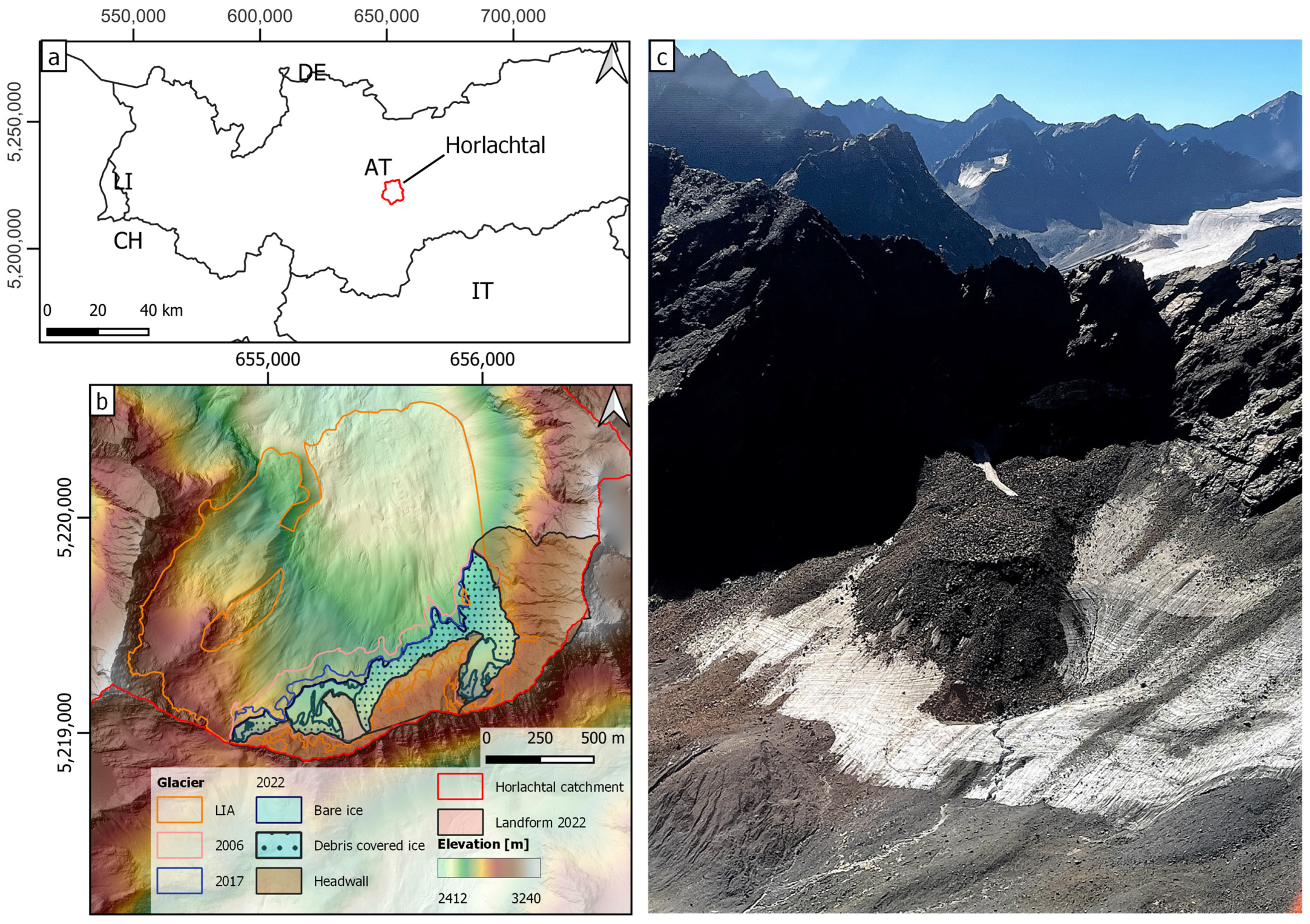
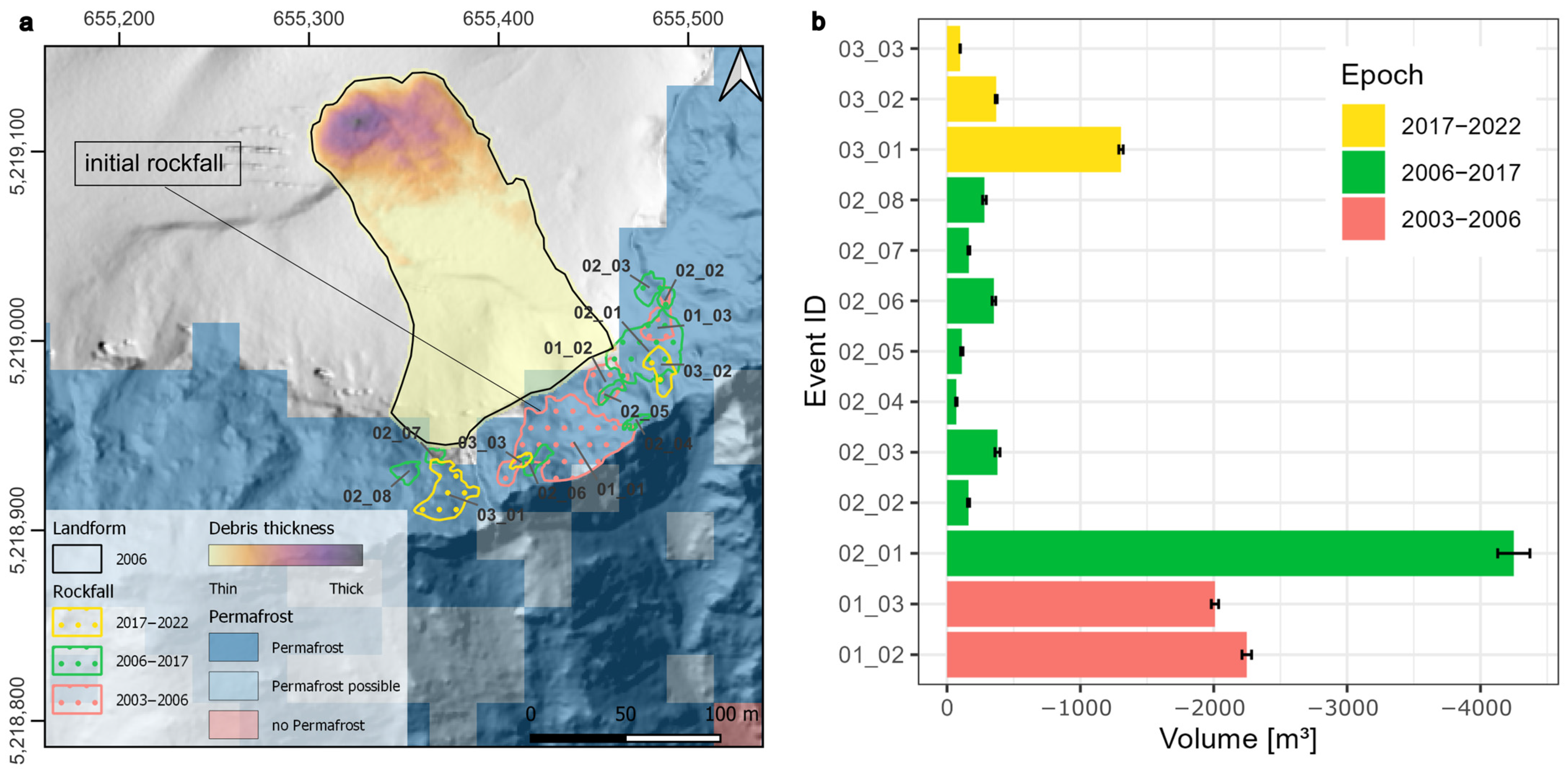
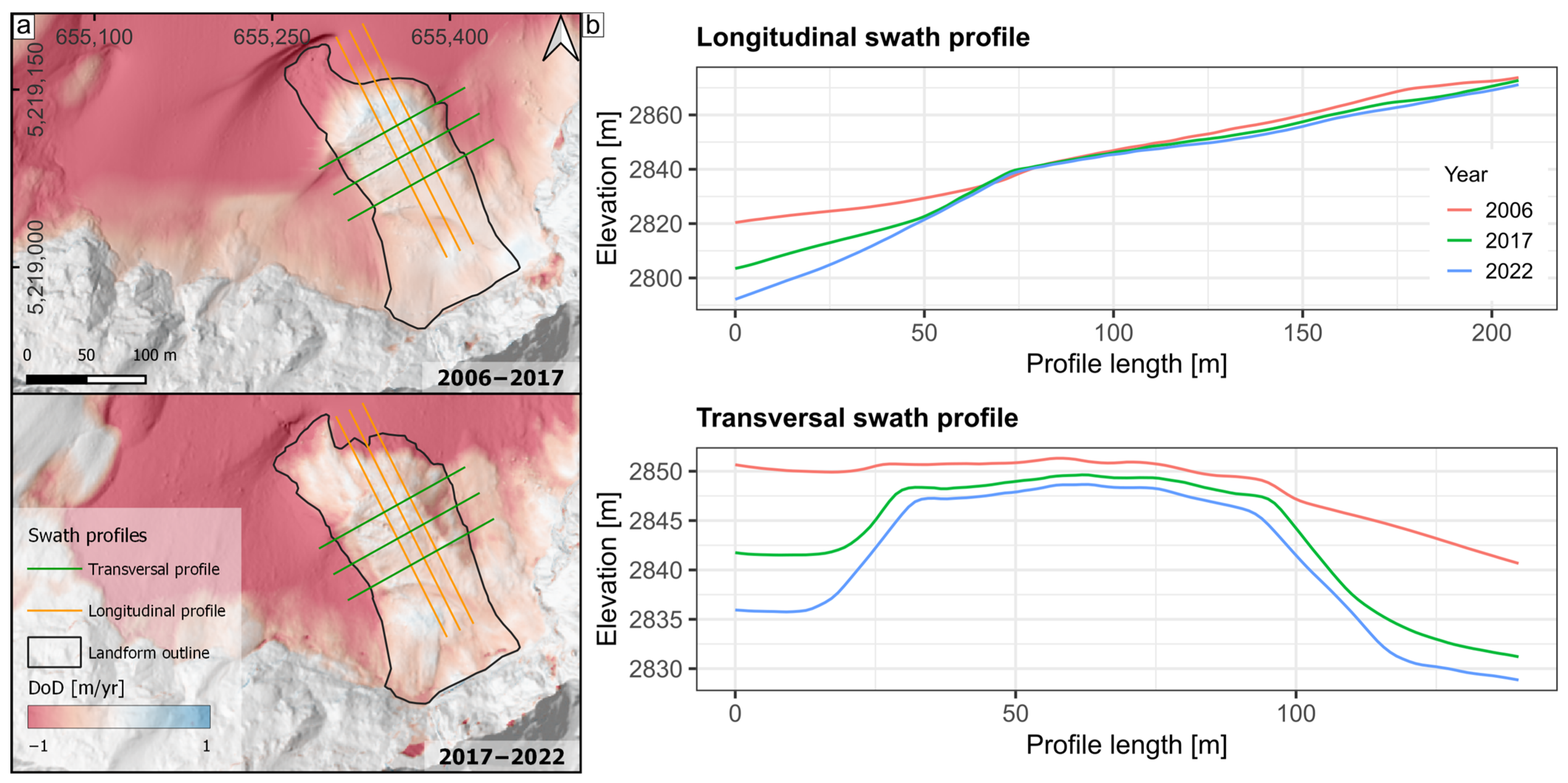

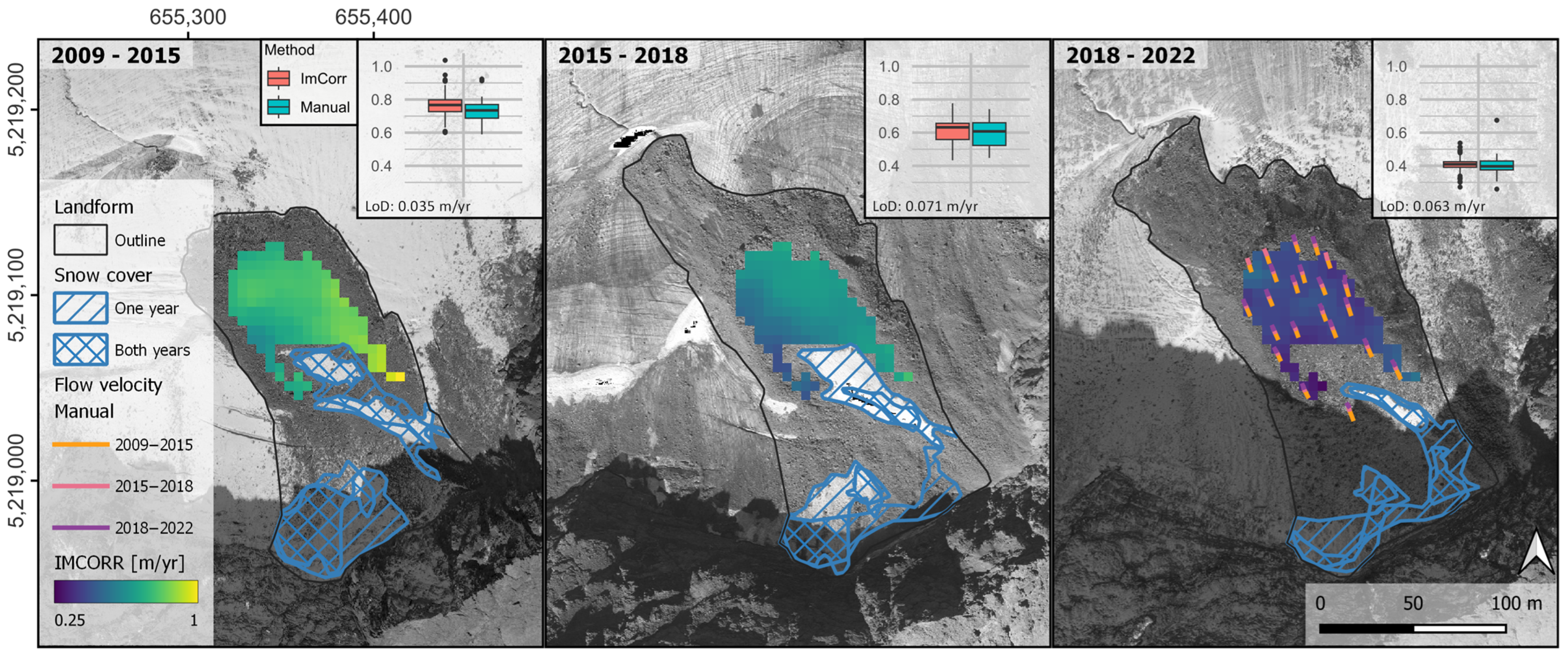
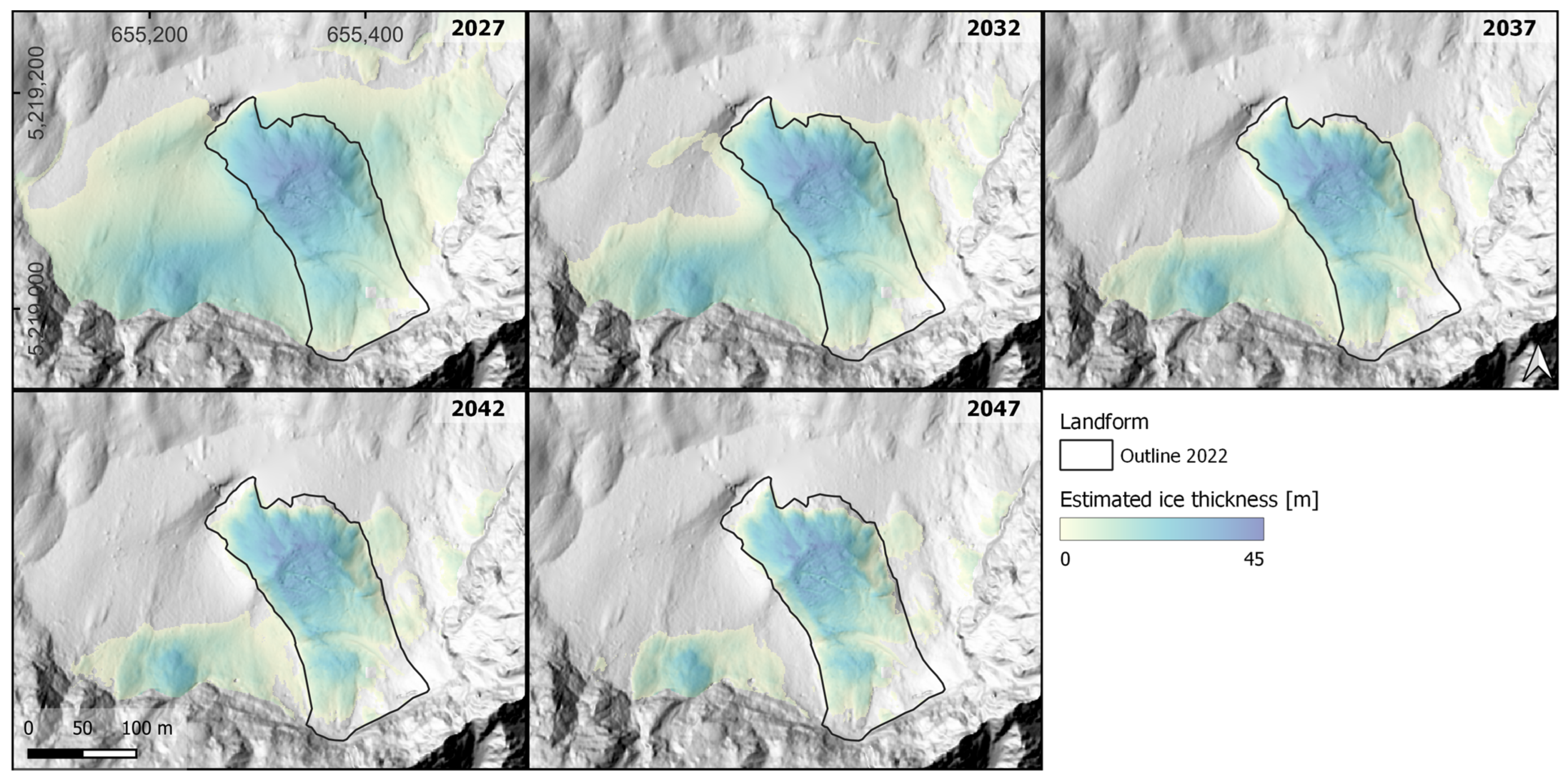
| Date | Data Type | Source | Point Density (pt/m2) | Raster Resolution (m) |
|---|---|---|---|---|
| 6 August 1973 | Photogrammetric point cloud | Images: State Tyrol; own processing | 1.8 | 1 |
| 6–7 September 2006 | ALS raster | State Tyrol | - | 1 |
| 19, 31 July 2017 | ALS raster | State Tyrol | - | 1 |
| 22 September 2021 | ALS point cloud | Own acquisition/processing | 13.7 | 1 |
| 4 August 2022 | ALS point cloud | Own acquisition/processing | 21.6 | 1 |
| Date | Type | Source | GSD * [m] |
|---|---|---|---|
| 4 August 1973 | Photogrammetric orthophoto | Images: State Tyrol; own processing | 0.2 |
| 4 September 2003 | Orthophoto | State Tyrol | 0.2 |
| 8 September 2009 | Orthophoto | State Tyrol | 0.2 |
| 27 August 2015 | Orthophoto | State Tyrol | 0.2 |
| 27 September 2018 | Orthophoto | State Tyrol | 0.2 |
| 4 August 2022 | Photogrammetric orthophoto | Own acquisition/processing | 0.03 |
Disclaimer/Publisher’s Note: The statements, opinions and data contained in all publications are solely those of the individual author(s) and contributor(s) and not of MDPI and/or the editor(s). MDPI and/or the editor(s) disclaim responsibility for any injury to people or property resulting from any ideas, methods, instructions or products referred to in the content. |
© 2023 by the authors. Licensee MDPI, Basel, Switzerland. This article is an open access article distributed under the terms and conditions of the Creative Commons Attribution (CC BY) license (https://creativecommons.org/licenses/by/4.0/).
Share and Cite
Fleischer, F.; Haas, F.; Altmann, M.; Rom, J.; Ressl, C.; Becht, M. Glaciogenic Periglacial Landform in the Making—Geomorphological Evolution of a Rockfall on a Small Glacier in the Horlachtal, Stubai Alps, Austria. Remote Sens. 2023, 15, 1472. https://doi.org/10.3390/rs15061472
Fleischer F, Haas F, Altmann M, Rom J, Ressl C, Becht M. Glaciogenic Periglacial Landform in the Making—Geomorphological Evolution of a Rockfall on a Small Glacier in the Horlachtal, Stubai Alps, Austria. Remote Sensing. 2023; 15(6):1472. https://doi.org/10.3390/rs15061472
Chicago/Turabian StyleFleischer, Fabian, Florian Haas, Moritz Altmann, Jakob Rom, Camillo Ressl, and Michael Becht. 2023. "Glaciogenic Periglacial Landform in the Making—Geomorphological Evolution of a Rockfall on a Small Glacier in the Horlachtal, Stubai Alps, Austria" Remote Sensing 15, no. 6: 1472. https://doi.org/10.3390/rs15061472
APA StyleFleischer, F., Haas, F., Altmann, M., Rom, J., Ressl, C., & Becht, M. (2023). Glaciogenic Periglacial Landform in the Making—Geomorphological Evolution of a Rockfall on a Small Glacier in the Horlachtal, Stubai Alps, Austria. Remote Sensing, 15(6), 1472. https://doi.org/10.3390/rs15061472








